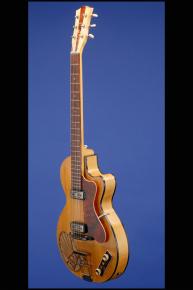'The Rarest of the Rare' With a Built-In Three Watt Amplifier and Speaker.
1960 HOFNER 126 CLUB 50 (MODEL 1260).
One of just three 'prototype' Hofner 126 (model 1260) Club 50's made in 1960, with a built-in three watt amplifier and speaker. Thirteen inch wide, two and a quarter inch thick, blond semi-solid, lightly arched single-cutaway body. Two-piece natural spruce top with lightly flamed one-piece maple back and sides and a three-piece maple/beech/maple neck with a tortoiseshell heel-cap. This featherweight guitar weighs just 4.70 lbs. and has a nut width of 1 11/16 inches, a scale length of 24 1/4 inches and a wonderful thick neck profile. Body 'double-bound' with black triple binding on the top and bottom edges. Brazilian rosewood fretboard with 'triple-layer' nut, 'zero' fret and 22 original medium frets with inlaid pearl dot position markers. Headstock with mother-of-pearl and tortoiseshell face (the mother-of-pearl and the tortoiseshell separated by two sets of black and white lines. Three-in-a row open-back strip tuners with oval white plastic buttons. Two Hofner 'Toaster' pickup with 'Diamond' logos and with low (neck) and high (bridge) pickup black plastic pickup surrounds and outputs of 7.97k and 8.95k. Original tortoiseshell pickguard with white edging. Two volume controls plus three 'slider' switches, all on rectangular tortoiseshell panel on treble bout. The 'Rhythm/Solo' slider switch activates the internal three watt amplifier. The other two slider switches control 'Bass' and 'Treble'. White plastic with gold top Hofner 'teacup' control knobs with securing grub screws. Hofner ebony bridge on ebony base with six individually adjustable individual saddles (actually lengths of fretwire). Hofne'r'trapeze' tailpiece with Karl Hofner 'tag'. On the bass side of the spruce top (by the tailpiece) is an intricately carved speaker grille (over striped cloth) with the "Hofner" logo. This unbelievably rare guitar is in near mint (9.25) condition with just some very light finish checking and a few small marks on the sides. Housed in a modern 'CNB' brown shaped hardshell case with silk liner and purple plush lining (9.25).
"For many players the most enduring and loved of all Hofner's original model lineup were the Club 50 and Club 40. These little guitars were light and immensely friendly to play - notwithstanding the thick necks of the early models. When amplifies, the Club exhibited a strong, warm tone which made it the perfect rhythm guitar." (Gordon Giltrap & Neville Marten. The Hofner Guitar - A History, p. 11).
"For a short period in 1960, Hofner experimented with two battery-operated guitars fitted with a built-in amplifier and loudspeaker. This equipment was fitted to the 126 "Club" model (Hofner 1260) and a totally new (and totally wierd!) guitar designed called the Fledermausguitarre, also known as the Hofner Bat Guitar. These guitars, particularly the Bat Guitar, were made in very small numbers and hence can really be considered to be only prototypes and /or exhibition guitars." (http://www.vintagehofner.co.uk/registration/regform/clubreg.html)
"Hofner were one of the very first manufacturers to offer active circuits in their guitars. They were basically introduced for players who did not use a conventional guitar amplifier, but who could plug into a domestic radio set or radiogram. The idea was that the active circuit would boost the signal to the radio receiver, hence increasing volume and improving the tone. As the Hofner catalogue stated "Our new electrc guitars with built-in audio-frequency pre-amplifier can be connected with any radio without a special amplifying set and will still attain a superb tone quality never effected up till now. Therefore it is not necessary anymore to purchase an expensive amplifier."
The circuit was powered by a 1.5 volt torch battery which was fitted into a special compartment, usually adjacent to the strap button at the bottom of the body in the guitar's side. This was covered by a nickel plated swivel cap. A three way chicken-head control was fitted to the body top which allowed the following functions:
All electrics turned off, allowing the guitar to be played as a full acoustic. Passive circuits turned for playing through a conventional amplifier. Active circuit switched on for playing through a radio, or indeed a conventional amplifier.
The model number of the particular guitar was given a "T" designation to indicate that it was a "transistor powered" instrument. i.e. a conventional 457/S/E2 archtop with normal passive electrics and two pickups would be designated as a 457/S/T2 if the optional active circuit was fitted. A single pickup active 457 guitar would be a 457/S/T1 and with three pickups - 457/S/T3.











